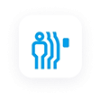Robotic automation is increasingly becoming popular in the industrial workplace. With its ability to perform tasks more efficiently and accurately than humans, businesses are rapidly investing in acquiring these intelligent machines. However, apart from efficiency and productivity, one of the often overlooked benefits of robotic automation is its potential to enhance workplace safety.
Accidents and injuries are common in industrial environments. In fact, according to the Occupational Safety and Health Administration (OSHA), in 2021, there were approximately 2.6 million nonfatal workplace injuries and 5,190 fatal injuries in the United States.
Robotic automation can remove workers from such hazardous environments and automate dangerous tasks to reduce the risk of workplace accidents and injuries significantly. The benefits of integrating robots are twofold. Not only are the workers safe, but automation will also improve productivity and reduce costs associated with workplace accidents.
Let's find out how robotic automation can enhance workplace safety and the benefits it can offer to organizations and employees alike.
How Robots Enhance Workplace Safety
Industrial facilities can enhance safety through robotic automation in several ways. Some of them are:
Robots can reduce physical injuries: When robots are given responsibility for doing repetitive, heavy and time-consuming manual tasks, it can bring down the physical harm caused by these tasks on workers. For example, robots can prevent workers from falling from heights or bring down the risk of musculoskeletal disorders (MSD), back injuries, and fatigue.
Robots can work safely in hazardous environments: Industrial facilities, including smart manufacturing facilities, are not free from dangerous working environments where workers may have to deal with fire, radiation, harmful chemicals or extreme temperatures. However, collaborative robots (cobots) and robotic arms can perform complex tasks with precision and accuracy in such dangerous working environments.
Robotic automation offers real-time insights: Robots use innovative technologies like sensors, alarms, and stop functions. These technologies empower robots to detect and avoid obstacles or workers in their path. In addition, these devices also help managers with real-time monitoring of the machines and processes. These insights eventually help decision-makers proactively carry out maintenance tasks and quickly detect anomalies in the processes to avoid potential hazards.
How to Enhance Workplace Safety with Robotic Automation
There is no doubt that robotics improves workplace safety and worker health. But robotics has its own risks that can negatively impact the safety of workplaces and workers. Following these three useful tips can mitigate the adverse effects of robotics in workplaces.
Create a workspace for robots
Businesses must design factory environments that can safely accommodate robotic devices. It might include choosing the right robotic cells and location. In addition, it is also important to consider factors such as robot-human traffic and the distance between humans and robots in the workplace.
Learn how robotics affect workplace safety
A common perception is that robots like cobots are safe as they are designed to work alongside humans. However, many robots, including cobots, are not suitable for every industrial task. Even the safest robots and their technical specifications require careful consideration to keep workers and robots safe while working in an industrial facility.
Therefore, it is essential to consider several factors when implementing robots in the workplace. These can include the size and weight of the robot, its speed and range of motion, and the tasks it will perform. Additionally, the environment in which the robot will operate must be taken into account, including factors such as lighting, temperature, and the presence of other machinery.
Using safety measures such as safety laser scanners, fences, safety mats, and safety interlocks will prevent accidental contact between humans and robots, ensuring a safe working environment for everyone.
Make a robot's path more visible
According to a report by The International Labor Organization, 2.3 million men and women meet with accidents every year while working in industrial facilities worldwide. As a result, over 6,000 people die every single day.
The causes of those accidents differ, but most of them arise when workers and machines are in the wrong place at the wrong time. Robots have sensors and other safety features, but it is critical to have visible paths for robots to prevent a collision. Using safety paints, differentiating colors, or lights to mark robots' paths can prevent workers from accidentally entering areas where the robots are operating, reducing the risk of collisions and other accidents.
Hokuyo: Your Partner in Robotic Automation and Safety
We are a global sensor and automation technology leader, offering a wide range of products that can help you prevent workplace accidents, improve productivity, and optimize your business operations.
With 75 years in business, we have a proven track record of delivering high-quality and cost-effective products to various industries and applications. Whether you need safety laser scanners, collision-avoidance sensors, light detection and ranging (LIDAR) or obstacle detection sensors, and optical data transmission devices, we have the right solution for you.
We also provide superior customer service and technical support to ensure your satisfaction.
Contact us today and find out how we can help enhance workplace safety through our high-quality sensors that could empower your robotic automation efforts.

 Factory Automation
Factory Automation Logistics Automation
Logistics Automation Process Automation
Process Automation Crane Collision Avoidance
Crane Collision Avoidance LiDAR/Obstacle Detection
LiDAR/Obstacle Detection Safety Laser Scanners
Safety Laser Scanners Optical Data Transmission
Optical Data Transmission Hot Metal Detectors
Hot Metal Detectors Laser Distance Sensor
Laser Distance Sensor Blog
Blog Whitepapers
Whitepapers Case Studies
Case Studies Infographics
Infographics